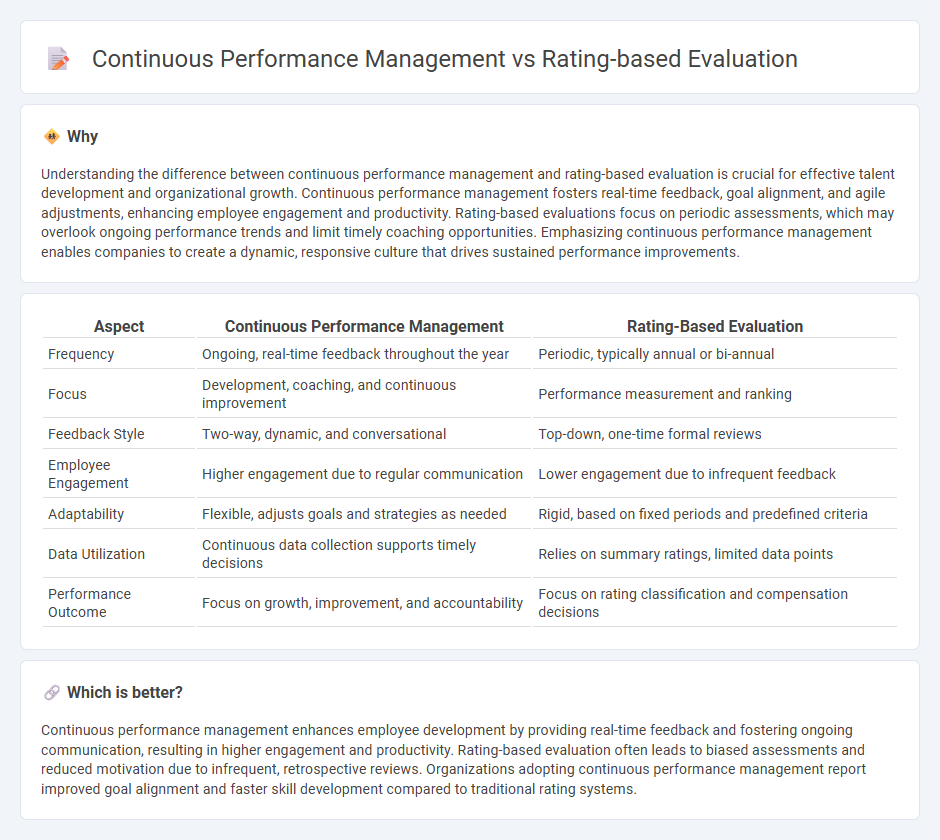
Continuous performance management emphasizes real-time feedback, regular check-ins, and ongoing development, fostering agile adaptation and employee growth. Rating-based evaluation relies on periodic assessments with numerical or qualitative scores, often linked to annual reviews and compensation decisions. Explore deeper insights to determine which approach best aligns with your organizational goals and workforce dynamics.
Why it is important
Understanding the difference between continuous performance management and rating-based evaluation is crucial for effective talent development and organizational growth. Continuous performance management fosters real-time feedback, goal alignment, and agile adjustments, enhancing employee engagement and productivity. Rating-based evaluations focus on periodic assessments, which may overlook ongoing performance trends and limit timely coaching opportunities. Emphasizing continuous performance management enables companies to create a dynamic, responsive culture that drives sustained performance improvements.
Comparison Table
| Aspect | Continuous Performance Management | Rating-Based Evaluation |
|---|---|---|
| Frequency | Ongoing, real-time feedback throughout the year | Periodic, typically annual or bi-annual |
| Focus | Development, coaching, and continuous improvement | Performance measurement and ranking |
| Feedback Style | Two-way, dynamic, and conversational | Top-down, one-time formal reviews |
| Employee Engagement | Higher engagement due to regular communication | Lower engagement due to infrequent feedback |
| Adaptability | Flexible, adjusts goals and strategies as needed | Rigid, based on fixed periods and predefined criteria |
| Data Utilization | Continuous data collection supports timely decisions | Relies on summary ratings, limited data points |
| Performance Outcome | Focus on growth, improvement, and accountability | Focus on rating classification and compensation decisions |
Which is better?
Continuous performance management enhances employee development by providing real-time feedback and fostering ongoing communication, resulting in higher engagement and productivity. Rating-based evaluation often leads to biased assessments and reduced motivation due to infrequent, retrospective reviews. Organizations adopting continuous performance management report improved goal alignment and faster skill development compared to traditional rating systems.
Connection
Continuous performance management fosters ongoing feedback and real-time goal adjustments, creating a dynamic environment for employee growth. Rating-based evaluation provides structured metrics that quantify performance outcomes, enabling objective assessments aligned with continuous insights. Integrating continuous management with rating systems enhances accuracy in appraisals and drives strategic human resource decisions.
Key Terms
Annual Appraisal
Rating-based evaluation relies on predefined performance scales during annual appraisals, often leading to snapshot assessments that may overlook ongoing employee development. Continuous performance management emphasizes regular feedback and real-time goal adjustments, fostering more dynamic and comprehensive performance tracking throughout the year. Discover how integrating both approaches can optimize appraisal outcomes and enhance workforce productivity.
Real-Time Feedback
Rating-based evaluation relies on periodic assessments that summarize employee performance using standardized metrics, often leading to delayed feedback and limited opportunities for immediate improvement. Continuous performance management emphasizes real-time feedback through frequent, informal check-ins that foster ongoing development and agile goal alignment. Discover how integrating real-time feedback can transform your performance management strategy and boost workforce engagement.
Goal Setting
Rating-based evaluation relies on periodic assessments to measure goal achievement, often leading to delayed feedback and performance adjustments. Continuous performance management emphasizes ongoing dialogue and real-time progress tracking, fostering adaptive goal setting and increased employee engagement. Explore the advantages of both approaches to optimize goal-setting strategies in your organization.
Source and External Links
Employee Performance Rating Scales in 2025: Examples and PDF - Rating-based evaluations commonly use scales (e.g., 5-point, 3-point, or 4-point) to assess employee performance across overall results, goal achievement, and competencies, providing structured and easy-to-implement methods to measure work quality and capabilities.
How to Choose the Right Performance Review Rating Scale for Your Team - A five-point performance rating scale is popular for its simplicity and intuitive setup but risks issues like rating centralization or inflation, which can skew evaluation data in rating-based performance reviews.
Performance review rating scale: Pros and cons for your business - Rating scales in performance reviews assign numerical or categorical scores to measure goals, behaviors, and competencies, facilitating quantifiable assessments that support feedback, promotion, and pay decisions, with formats ranging from simple 3-point to detailed 10-point and behaviorally anchored rating scales.
 dowidth.com
dowidth.com